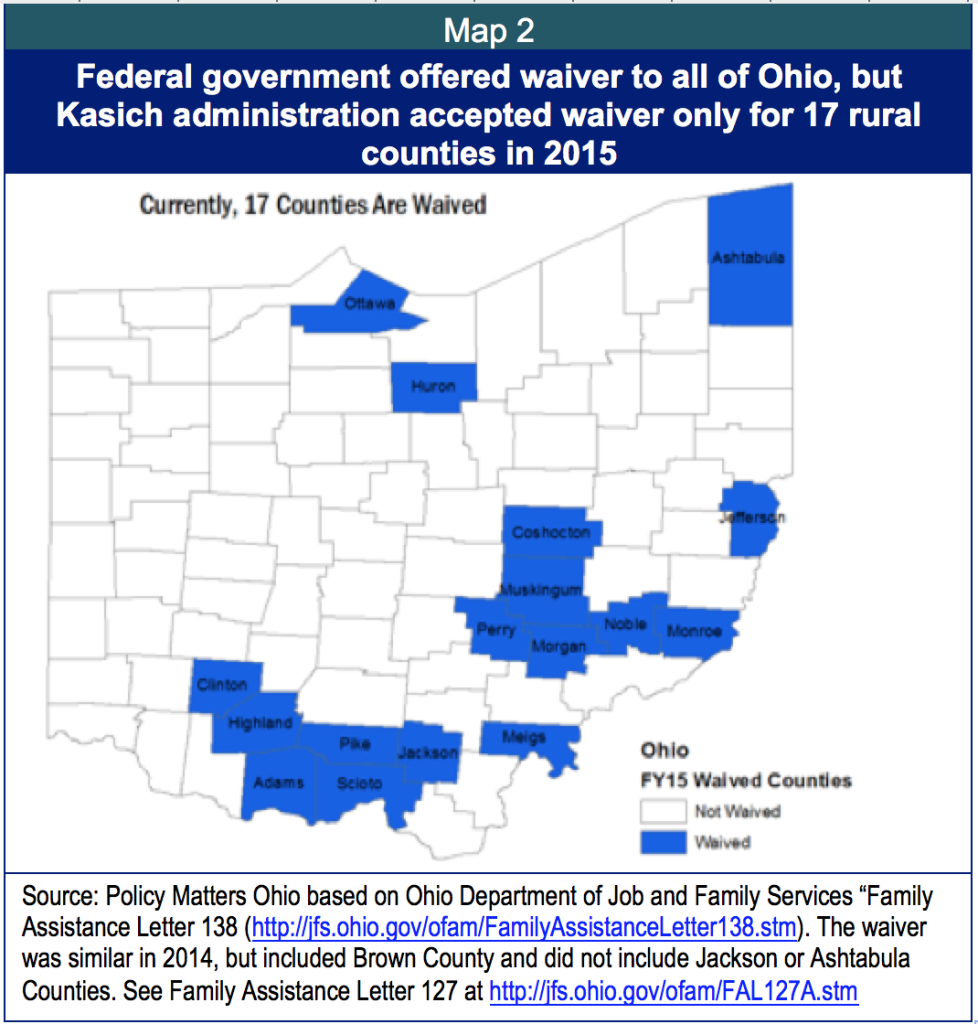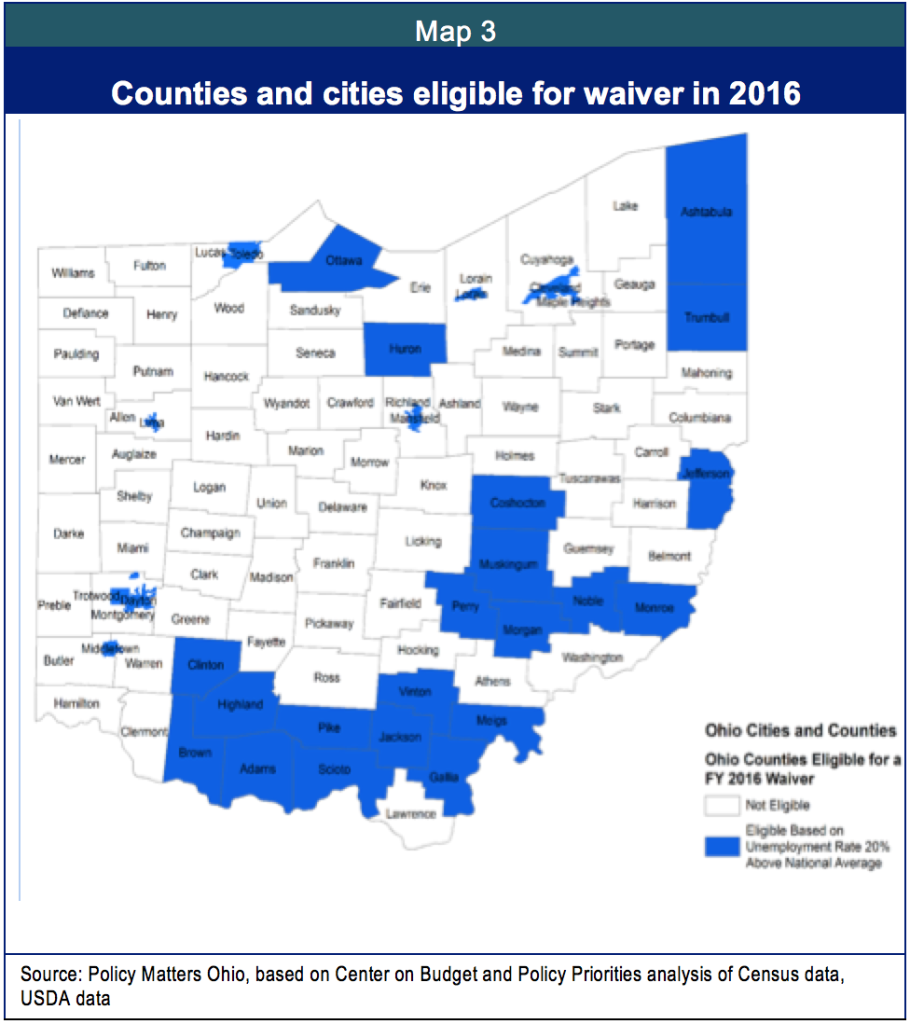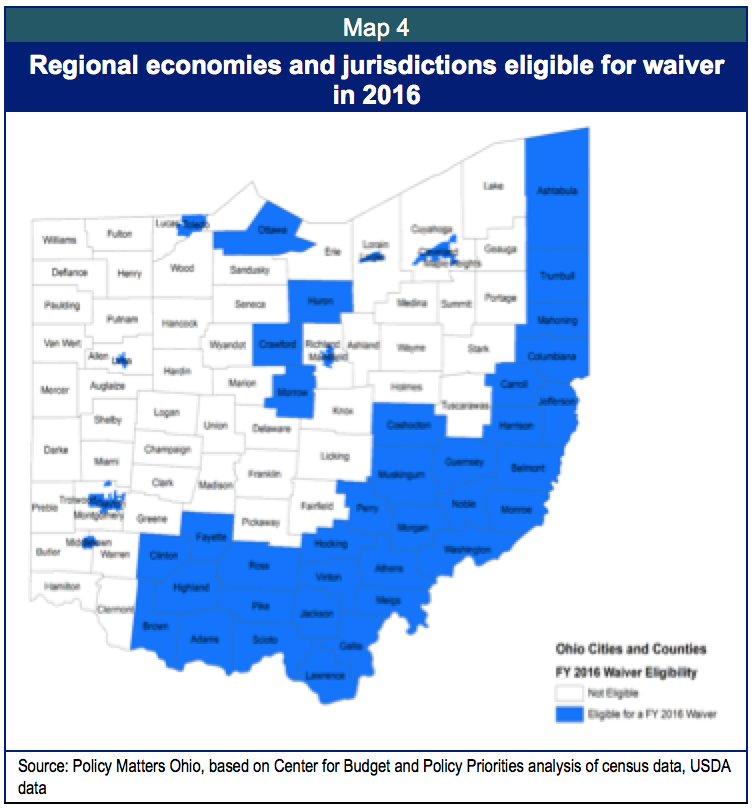
Stop the Hunger Games: Ohio should maximize access to food aid
July 30, 2015
Stop the Hunger Games: Ohio should maximize access to food aid
July 30, 2015
Contact: Wendy Patton, 614.221.4505
By Wendy Patton
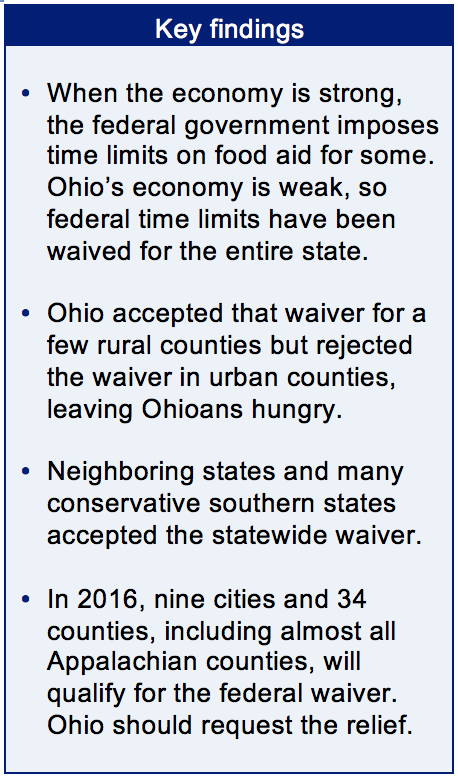 The Kasich administration could help more Ohioans become self-sufficient by ensuring the Supplemental Nutrition Assistance Program (SNAP, or food aid) is used to the fullest extent possible throughout the state. For the past two years, Ohio permitted time limits in the SNAP program to reduce access to food assistance in most counties, although the entire state qualified for a waiver of such restrictions. While a statewide waiver may not be available next year, many counties and cities will remain eligible. Ohio should seek such a waiver in as many places as possible to help reduce the problem of hunger and food insecurity throughout the state.
The Kasich administration could help more Ohioans become self-sufficient by ensuring the Supplemental Nutrition Assistance Program (SNAP, or food aid) is used to the fullest extent possible throughout the state. For the past two years, Ohio permitted time limits in the SNAP program to reduce access to food assistance in most counties, although the entire state qualified for a waiver of such restrictions. While a statewide waiver may not be available next year, many counties and cities will remain eligible. Ohio should seek such a waiver in as many places as possible to help reduce the problem of hunger and food insecurity throughout the state.
For many Ohioans, the recession never ended. Demand in Ohio’s food banks rose by 40 percent between 2010 and 2014.[1] Today, the Ohio Association of Foodbanks estimates that one in six Ohioans is at risk of hunger.[2] The United States Department of Agriculture (USDA) found that Ohio’s average share of households facing food insecurity (16 percent) was 10 percent higher than the national average. We ranked 12th among the states in food insecurity and tied with Mississippi for a ranking of 3d in terms of households with very low food security, with a share 35 percent higher than in the nation as a whole.[3]
When the economy is strong, the federal government places time limits on food aid for job-seekers who are not disabled, elderly or parents with custody of minor children. These people are eligible for federal food aid in just three out of 36 months unless they get 80 hours of work a month (about 20 hours a week). When a state or local economy is weak and many can’t find this much work, federal rules waive the time limits. Ohio has qualified for a federal waiver of time limits since the recession. However, the Kasich administration rejected that waiver for urban counties for the past two years, accepting it in 2014 for a few rural counties (16 out of Ohio’s 88 counties in 2014 and 17 in 2015). This means that while some of our rural residents can rightly get the help they need, urban neighbors in similar straits have been denied this most basic form of assistance.Next year Ohio will no longer be eligible for a statewide waiver, but many counties and cities will remain eligible. In this report, we identify up to 34 counties that will qualify, and nine additional cities. The Kasich administration should apply for the broadest waiver possible and maximize federal food aid for hungry Ohioans throughout the state.
Food aid in America
The Supplemental Nutrition Assistance Program (SNAP, formerly known as the food stamp program) is the nation’s most important anti-hunger program. People with disposable income at the federal poverty level (about $11,676 for a single person in 2015) are eligible for this federal assistance. SNAP currently helps about 46 million low-income Americans.[4] Of the 1.7 million Ohioans assisted in June of 2015 by the federal program, 1.4 million (82 percent) are children, seniors or disabled.[5]
In 1996, Congress passed time limits and work requirements for non-disabled, non-elderly adults without custody of minor children in the federal food assistance program. Ohio representatives John Kasich and Rob Ney sponsored these provisions, emphasizing that states would offer people who could not find jobs enrollment in “workfare” programs and that their amendment provided for a waiver of these rules in places of high unemployment.[6] Federal law, however, neither required states to offer workfare programs or job training to people unable to find a job nor provided funds to states for that purpose. Most states do not offer these programs, in part because operating a work program with enough slots for everyone at risk of hitting the three-month time limit is too expensive.[7] Waivers to the time limits based on high local or state unemployment have been more helpful. Time limits have been waived for most of the nation since the recession. Because of continued high unemployment, 35 states and the District of Columbia were eligible for a statewide waiver in 2015. Of those, 31 requested the waiver for the entire or vast majority of their state -- including most of our neighboring states and politically conservative southern states (Map 1).
Restriction of food aid in Ohio
In 2014, Ohio qualified for a statewide waiver of time limits, but instead requested a partial waiver for just 16 counties: Adams, Brown, Clinton, Coshocton, Highland, Huron, Jefferson, Meigs, Monroe, Morgan, Muskingum, Noble, Ottawa, Perry, Pike and Scioto. In 2015, Ohio again qualified for a statewide waiver, but only requested the waiver for a group of 17 counties, mostly the same as in 2016 (Ashtabula and Jackson were added; Brown was dropped). These were rural counties with small populations, so about 8,850 individuals were covered by the exemption, leaving approximately 134,000 beneficiaries in non-waiver counties. Five cities in non-waiver counties – East Cleveland, Cleveland, Dayton, Lima, and Trotwood – officially qualified but were not given exemptions.[8]
The counties in which time limits were waived in 2015 are shown on Map 2, highlighted in blue.
In the white areas of the map, non-elderly, able-bodied adults without children in their custody who could not find enough work hours were dropped from the SNAP program after three months. Although some Ohio counties and cities were able to provide alternatives that kept some people from losing food aid, not enough services of this type were available statewide. Figure 1 illustrates the impact of time limits on waived and unwaived counties. The SNAP caseload in Hamilton County dropped sharply as time limits were imposed at the beginning of 2014. A similar pattern emerged in Cuyahoga, Lucas, Mahoning and Franklin counties. A more gradual rate of caseload decline occurred in counties where the waiver of time limits was retained, illustrated by caseload trends in Clinton County on Figure 1.
In September 2013, 140,868 job seekers in Ohio faced a cut-off of benefits when the waiver expired. By March 2014, an estimated 19,419 had been terminated under the time limits.[9] In June 2015, there were 49,944 in similar straits – subject to the three-month time limits – enrolled in SNAP. [10]
Overall enrollment in the SNAP program declined by 3.5 percent between October 2013 and June 2015 (from 1.80 million to 1.73 million Ohioans.).[11] By contrast, enrollment of people subject to time limits dropped by 64.5 percent (from 140,868 to 49,944 Ohioans).
Did those who lost food aid because of time limits get jobs? The steep rise in demand for food aid at food pantries and food banks suggests they did not. In the current budget, state funding for food pantries and food banks rose by 26 percent over funding in the prior biennial budget – by $10.5 million dollars – as demand for food aid soared.
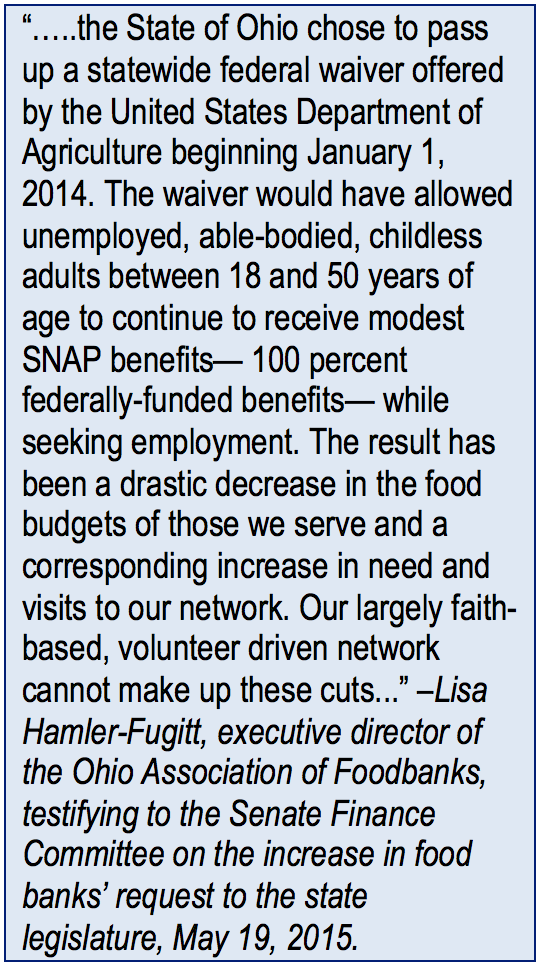 Many who lost food aid face barriers to employment. In 2014, the Ohio Association of Foodbanks surveyed more than 4,100 in Franklin County who lost SNAP benefits when Ohio rejected the waiver of time limits for job seekers.[12] About a third (30.8 percent) had a physical or mental health issue that limited their ability to work. Nearly a fifth (17.8 percent) had applied for disability because of illness. Obtaining work was complicated for those who needed special accommodations (8.2 percent) because of disability such as breathing problems or back pain. Just over half (54 percent) had applied for Medicaid.[13]
Many who lost food aid face barriers to employment. In 2014, the Ohio Association of Foodbanks surveyed more than 4,100 in Franklin County who lost SNAP benefits when Ohio rejected the waiver of time limits for job seekers.[12] About a third (30.8 percent) had a physical or mental health issue that limited their ability to work. Nearly a fifth (17.8 percent) had applied for disability because of illness. Obtaining work was complicated for those who needed special accommodations (8.2 percent) because of disability such as breathing problems or back pain. Just over half (54 percent) had applied for Medicaid.[13]
Time limits hurt people looking for work, workers whose schedules give them less than 80 hours per month, people in temporary jobs, people without reliable transportation (especially in rural areas and small cities, where there is limited public transit) and people who can’t find work because of physical or mental illness. Because of this policy, these struggling people now face the additional challenge of hunger. They cannot get food assistance because they are not working enough, yet an inadequate diet can keep them from succeeding at work.
The counties where Ohio accepted the waiver of time limits were are rural, although more than 70 percent of affected SNAP participants live in the urban counties of Cuyahoga, Franklin, Hamilton, Montgomery, Summit, Lucas, Stark, Mahoning, Butler and Lorain Counties.[14] All of these counties would have been included under the statewide waiver offered by the federal government, but cities within these counties could have been waived on their own under U.S. Agriculture Department rules.
The exclusion of cities and urban counties meant many African American, Asian and Hispanic Ohioans, who live mostly in cities, were excluded from food aid. In the summer of 2014, Ohio Legal Aid filed a civil complaint against the state of Ohio based on rejection of the work requirement waiver in Ohio’s cities, because it disproportionately harmed minority populations.[15] At time of publication, no findings had been made on this civil action.
Ohio could do a better job in 2016
States have broad latitude to define where to seek waivers. The Kasich administration used a 24-month average unemployment rate of 20 percent higher than the national average to identify counties for a partial waiver in 2014 and 2015.[16] Using this same approach, 21 counties and nine cities that are not in exempted counties would qualify for a waiver in 2016 (Map 3).[17]
Table 3 shows the nine cities outside of qualifying counties that would be eligible for the waiver.
Map 4 illustrates how under federal SNAP rules, counties and cities can be eligible for a waiver based on lagging regional economies. Using this approach, 34 Ohio counties, as well as the cities listed on Table 3, would be eligible.[18]
The table in the appendix shows the 24-month unemployment rates that would support a request for a waiver of work requirements for counties in Maps 3 and 4 and cities in Table 3.
Ohio’s recently passed budget bill, House Bill 64, specifies that rules governing SNAP in Ohio must be consistent with federal rules and provides a small amount of additional, one-time state funding ($1 million over two years) to enhance employment and training services to SNAP participants – a small amount of money for a big problem. Most states do not offer this programming because operating a work program with enough slots for everyone at risk of hitting the three-month time limit is expensive, [19] however, additional federal funds are available to states that commit to serving those facing time limits. Ohio should seek these additional federal funds.[20] Finally, Ohio should also use our large backlog of time-limit “exemptions” built up over the years. Ohio will have as many as 484,627 such exemptions available for use by the end of the current fiscal year.[21] Each exemption serves as one additional month of food aid for someone affected by time limits. Use of these exemptions is another way to maximize federal aid to relieve hunger in Ohio.
Ohio’s new budget bill, House Bill 64, contains language mandating improved case management services to help those in need of work or training. The initial focus is on young adults 16 to 24, but the average age of Ohioans subject to the federal time limits on food aid is 34.[22] A small grant program (“Healthier Buckeye” – funded at $5 million for the first year of the budget and $6.5 million for the second year) is created to help counties experiment with new techniques – again, a small sum of one-time money in the face of a significant loss of federal aid. The Ohio Association of Foodbanks estimates the state has lost 277 million meals with an estimated value of $385 million dollars since October 2013 due to a combination of federal reductions in the SNAP aid and the state rejection of the time limit waiver.[23]
It is crucial that even as the state works to improve safety net services, access to federal food aid be used to the fullest extent possible.
Summary and conclusion
In 2014 and 2015, Ohio’s economy was weak. As a result, the federal government did not believe that hungry Ohioans could find enough hours of work to meet their usual requirements. The federal government offered to waive time limits for food aid in Ohio, as they did in 35 other states. Even with hunger high and minimal economic growth in many places, Ohio was one of few states to reject the waiver for most counties.
The General Assembly and the Kasich administration have talked at length about improving safety net services for the poor. The budget bill includes a small new grant program for creating innovative ways for counties to improve employment and training services and encourages better case management techniques - for young people in 2016 and for all job seekers in the following year.
While Ohio tests new approaches, the state should ensure that hungry people in all counties can eat. Our analysis indicates up to 34 counties (including almost all of the counties in the Ohio Appalachian region) and 9 cities could have time limits waived in 2016, helping thousands. Ohio should pursue the broadest waiver possible. We should also pursue additional federal employment and training funds for job seekers facing time limits in the SNAP program, and we should fully utilize all banked exemptions to make food aid in the state stretch further.
[1] Hunger in America 2014: State Report for Ohio. Sept. 2014. Prepared by Urban Institute and Westat. Retrieved from http://ohiofoodbanks.org/docs/publications/hunger_in_OH_2014_summary.pdf. See Lisa Hamler-Fugitt, Executive Director of the Ohio Association of Foodbanks, testimony to the Senate Committee on Medicaid, May 20, 2015.
[2] Hamler-Fugitt, Op.Cit.
[3] “Food insecurity” is the United Stated Department of Agriculture measure for households with difficulty at some time during the year providing enough food for all their members due to a lack of resources. “Very low food security” refers to households in which the food intake of some household members was reduced and normal eating patterns were disrupted at times during the year due to limited resources. See Alisha Coleman-Jensen, Christian Gregory, Anita Singh, “Household Food Security in the United States in 2013,” Table 5, United States Department of Agriculture, September 2014 at http://www.ers.usda.gov/media/1565415/err173.pdf .
[4] United States Department of Agriculture, Food and Nutrition Service, Monthly data – national level (July 10, 2015) at http://www.fns.usda.gov/pd/supplemental-nutrition-assistance-program-snap
[5] E-mail from Ohio Department of Job and Family Services’ (ODJFS) Office of Communications, July 15, 2015.
[6] Library of Congress, Thomas Database, Congressional Record, July 18, 1996, p. 7906 (http://thomas.loc.gov/cgi-bin/query/F?r104:14:./temp/~r104ONg9Xp:e1108522: ).
[7] Ed Bolen, “Approximately 1 Million Unemployed Childless Adults Will Lose SNAP Benefits in 2016 as State Waivers Expire, Center on Budget and Policy Priorities, January 25, 2015 at http://www.cbpp.org/research/food-assistance/approximately-1-million-unemployed-childless-adults-will-lose-snap-benefits
[8] Jon Honeck, “State Chooses to Implement SNAP Work Requirements, State Budgeting Matters, Center for Community Solutions, January 2014 at http://www.communitysolutions.com/assets/docs/Common_Ground/cg_january2014_011514.pdf
[9] E-mail from the ODJFS Office of Communications, December 29, 2014.
[10] E-mailed communication from the ODJFS Office of Communications, July 22, 2015.
[11] ODJFS “Public Assistance Monthly Statistics at http://jfs.ohio.gov/pams/archive.stm
[12] “A comprehensive assessment of able-bodied adults without dependents and their participation in the work experience program in Franklin County, Ohio,” Report of 2014, Franklin County Department of Job and Family Services and The Ohio Association of Foodbanks, http://admin.ohiofoodbanks.org/uploads/news/WEP-2013-2014-report.pdf
[13] Id. Note that In May 2015, the Ohio Association of Foodbanks testified that across their network, over 66 percent of the two million Ohioans who relied on foodbanks last year were making the tough choice between food and medicine or medical care. Lisa Hamler-Fugitt, Testimony on Amended Substitute House Bill 64 to the Ohio Senate Medicaid Committee, May 20, 2015.
[14] Center for Community Solutions, “Common Ground,” Volume 1, #2, January 2014 at http://www.communitysolutions.com/assets/docs/Common_Ground/cg_january2014_011514.pdf
[15] Administrative complaint filed with the Office of the Assistance Secretary for Civil Rights, United States Department of Agriculture, 8-14-2015
[16] E-mail from Jennifer Weatherly, United States Department of Agriculture Food and Nutrition Service FOIA and Privacy Act Officer, to Brant Duda, Policy Matters Ohio, December 18, 2014.
[17] 7 CFR 273.24 (f) explains that an area is eligible for a waiver from the time limit if an area has insufficient jobs; one of the ways a state can support the claim of insufficient jobs is providing evidence that shows that an area “has a 24-month average unemployment rate 20 percent above the national average for the same 24-month period. This 24-month period may not be any earlier than the same 24-month period the ETA [Employment and Training Administration of the Department of Labor] uses to designate LSAs [Labor Surplus Areas] for the current fiscal year.” For 2016, the Department of Labor will use the period of January 2013-December 2014 to designate Labor Surplus Areas, so a state can use 24-month average unemployment data that begins no earlier than January 2013. For the time period of January 2013-December 2014, which was used in this analysis, the national average was 6.8 percent, and 20 percent above that was 8.1 percent, which is the average unemployment rate an area must have for this time period to qualify for a waiver.
[18] See footnote above on calculations based on 24-month unemployment rates. Note that in addition, the regulations [ 7 CFR 273.24 (f) ] also provide that a state can define the area covered by the waiver. In recent years, the Agriculture Department has allowed states to group together areas that are contiguous, or that belong to the same economic region, as defined by the state, and states commonly have waivers approved based on these groupings. When grouping together areas such as counties, the unemployment rate for the entire group of counties must meet the threshold of 20 percent above the national average for the 2-year period, even if individual counties do not qualify on their own.
[19] Bolen, Op.Cit.
[20] The Food and Nutrition Act provides $20 million each fiscal year for State agencies that pledge to offer a qualifying SNAP Employment and Training (E&T) component to all at-risk ABAWDs. At-risk ABAWDs are in their third countable month and could lose SNAP eligibility due to the time limit. Eligible State agencies are ones that commit to offer a qualifying education, training, or workfare opportunity to every ABAWD applicant or recipient (not waived or exempted) who is in the last month of the 3-month period of eligibility. From “Guide to serving ABAWDs subject to time limited participation,” p.13, United States Department of Agriculture, 2015 at http://www.fns.usda.gov/sites/default/files/Guide_to_Serving_ABAWDs_Subject_to_Time_Limit.pdf
[21] E-mail from ODJFS Office of Communications, July 23, 2015.
[22] Franklin County Department of Job and Family Services and Ohio Association of Foodbanks, Op.Cit.
[23] Lisa Hamler-Fugitt, Testimony to the Senate Medicaid Committee on May 20, 2015, Op.Cit; see also Ohio Association of Foodbanks, Losing Ground, Research Brief, December 2014 at http://ohiofoodbanks.org/docs/publications/losing_ground.pdf
Tags
2015Basic NeedsWendy PattonPhoto Gallery
1 of 22

